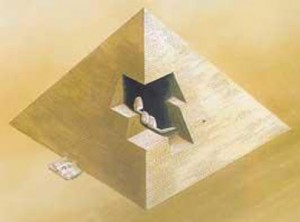The inscriptions found on the back of the casing stones gave us clues to how long the pyramid took to build and also revealed the sequence of work that took place. An inscription found at the base of this pyramid has shown that work had started during the year of the 15th cattle count of Snofru’s reign. Since the cattle counts were held at irregular intervals during this reign, this refers to somewhere between Snofru’s 15th and 30th year. It is very likely that the pyramid construction was started at the time when structural problems encountered when building the Bent Pyramid forced the builders to temporarily abandon this project.
 Interestingly, a second inscription found 30 courses of stones higher is dated 2 to 4 years later than the inscription found at the base. This gives an idea about the speed at which the Egyptians were able to build a monument like this pyramid. Within four years, 30 percent of the pyramid had been completed, and the entire pyramid was finished in about seventeen years. There is little doubt that Snofru was finally buried in this pyramid, although the fragments of human remains found inside the burial chamber are not certain to have been his. Interestingly, during the reign of Pepi I of the 6th Dynasty, this pyramid along with its southern neighbor, the Bent Pyramid, was considered as one estate.
Interestingly, a second inscription found 30 courses of stones higher is dated 2 to 4 years later than the inscription found at the base. This gives an idea about the speed at which the Egyptians were able to build a monument like this pyramid. Within four years, 30 percent of the pyramid had been completed, and the entire pyramid was finished in about seventeen years. There is little doubt that Snofru was finally buried in this pyramid, although the fragments of human remains found inside the burial chamber are not certain to have been his. Interestingly, during the reign of Pepi I of the 6th Dynasty, this pyramid along with its southern neighbor, the Bent Pyramid, was considered as one estate.